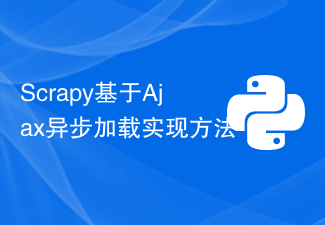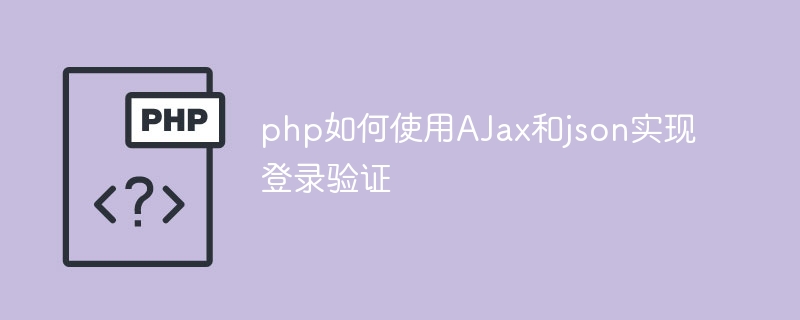 Backend Development
Backend Development PHP Tutorial
PHP Tutorial Back, forward and refresh after PHP development combined with AJAX (1)_PHP tutorial
Back, forward and refresh after PHP development combined with AJAX (1)_PHP tutorial
Introduction
Part 1 introduces how to develop a basic photo album with Sajax, PHP and JavaScript. As we build the history stack for our application, we'll rely on client-side technology and tie it directly into the code from Part 1. This article assumes the reader has knowledge of JavaScript and browser cookies.
Save state in browser
When surfing the Internet, you are always going from one page to another, and one site to another. In this process, the web browser faithfully records the history of where you have been, creating a digital trail of breadcrumbs that can be followed step by step back to the starting point. The back button allows you to go back to where you were before your previous action, and in this sense it is the undo button of the web.
The Web is a media divided by pages. The back and forward buttons in the browser toolbar guide the browser from one page to another. When Macromedia's Flash became all the rage, developers and users discovered that Rich Internet Applications (RIAs) broke the mold. Users can browse several sites, then log into a Flash-based site and spend a few minutes on it. The game ends when the user clicks the back button. The user has not returned to the previous Flash site and has no idea where he has arrived.
The same is true for websites based entirely on Ajax - another form of RIA. Websites that allow users to interact with a page multiple times are susceptible to the back button, or any history button (for that matter). The problem with the forward and reload buttons is the same as the problem with the back button. The internal history mechanism built into web browsers is an inescapable problem. For security reasons, developers cannot tamper with the browser history or any related buttons. There is also the issue of usability. Imagine how confused the user would be if the back button suddenly popped up with a cryptic warning or the user was sent to a new website.
Build a history stack
Although the browser history cannot be changed, you can build a history for use in the RIA. Obviously, it should be somewhat separate from the browser's standard navigation tools, but as stated earlier, rich applications depart somewhat from the Web's standard page-to-page model.
We will build a stack to manage the application's historical event records, which means storing a list and adding elements at the end of the list. The stack is used to store data in last-in-first-out (LIFO) order. Although the data at the top of the stack is not deleted during rollback, this model is very close to our needs. In JavaScript, stacks can be managed using arrays.
Along with the stack is a pointer indicating our current position in the stack. When we click in the application, a new event is pushed to the top of the stack, with the pointer pointing to the last element added. When you click the application's back and forward buttons, new events are not added to the stack, but the stack's pointer is moved. Think about what happens in the history stack when you use the back button: the browser returns to the last page viewed, and the forward button that was previously unavailable suddenly becomes available. When browsing a new page, the forward button turns gray again. Elements saved later in the browser history are popped off the stack, and new events are pushed onto the top of the stack. We will reproduce this behavior in the history stack we create.
Our goal is to create a set of usable history buttons: Back, Forward, and Refresh, as shown in Figure 1.
 Scrapy基于Ajax异步加载实现方法Jun 22, 2023 pm 11:09 PM
Scrapy基于Ajax异步加载实现方法Jun 22, 2023 pm 11:09 PMScrapy是一个开源的Python爬虫框架,它可以快速高效地从网站上获取数据。然而,很多网站采用了Ajax异步加载技术,使得Scrapy无法直接获取数据。本文将介绍基于Ajax异步加载的Scrapy实现方法。一、Ajax异步加载原理Ajax异步加载:在传统的页面加载方式中,浏览器发送请求到服务器后,必须等待服务器返回响应并将页面全部加载完毕才能进行下一步操
 如何使用CakePHP中的AJAX?Jun 04, 2023 pm 08:01 PM
如何使用CakePHP中的AJAX?Jun 04, 2023 pm 08:01 PM作为一种基于MVC模式的PHP框架,CakePHP已成为许多Web开发人员的首选。它的结构简单,易于扩展,而其中的AJAX技术更是让开发变得更加高效。在本文中,将介绍如何使用CakePHP中的AJAX。什么是AJAX?在介绍如何在CakePHP中使用AJAX之前,我们先来了解一下什么是AJAX。AJAX是“异步JavaScript和XML”的缩写,是指一种在
 jquery ajax报错403怎么办Nov 30, 2022 am 10:09 AM
jquery ajax报错403怎么办Nov 30, 2022 am 10:09 AMjquery ajax报错403是因为前端和服务器的域名不同而触发了防盗链机制,其解决办法:1、打开相应的代码文件;2、通过“public CorsFilter corsFilter() {...}”方法设置允许的域即可。
 Nginx中404页面怎么配置及AJAX请求返回404页面May 26, 2023 pm 09:47 PM
Nginx中404页面怎么配置及AJAX请求返回404页面May 26, 2023 pm 09:47 PM404页面基础配置404错误是www网站访问容易出现的错误。最常见的出错提示:404notfound。404错误页的设置对网站seo有很大的影响,而设置不当,比如直接转跳主页等,会被搜索引擎降权拔毛。404页面的目的应该是告诉用户:你所请求的页面是不存在的,同时引导用户浏览网站其他页面而不是关掉窗口离去。搜索引擎通过http状态码来识别网页的状态。当搜索引擎获得了一个错误链接时,网站应该返回404状态码,告诉搜索引擎放弃对该链接的索引。而如果返回200或302状态码,搜索引擎就会为该链接建立索引
 Swoole与Laravel框架的完美结合Jun 13, 2023 pm 08:36 PM
Swoole与Laravel框架的完美结合Jun 13, 2023 pm 08:36 PM随着互联网的快速发展,Web应用程序的需求也越来越大。对于Web开发者而言,选择一款优秀的Web应用框架是必不可少的。在PHP领域,Laravel已经成为了一款备受欢迎的Web应用框架。但是,对于高并发、高负载的场景,PHP的传统CGI模式下的Web应用程序并不太适合。这时,一个高性能的网络通信框架就显得尤为重要,而Swoole就是一个非常优
 什么是ajax重构Jul 01, 2022 pm 05:12 PM
什么是ajax重构Jul 01, 2022 pm 05:12 PMajax重构指的是在不改变软件现有功能的基础上,通过调整程序代码改善软件的质量、性能,使其程序的设计模式和架构更合理,提高软件的扩展性和维护性;Ajax的实现主要依赖于XMLHttpRequest对象,由于该对象的实例在处理事件完成后就会被销毁,所以在需要调用它的时候就要重新构建。
 探索PHP与区块链的完美结合Mar 27, 2024 pm 02:12 PM
探索PHP与区块链的完美结合Mar 27, 2024 pm 02:12 PM探索PHP与区块链的完美结合随着区块链技术的逐渐成熟和应用范围的不断拓展,人们开始尝试将传统的编程语言与区块链进行结合,以实现更多种类的应用。在这样的背景下,PHP语言作为一种被广泛应用的网络编程语言,也被人们开始探索与区块链技术的结合。本文将围绕PHP语言与区块链技术的结合展开探讨,其中将会涉及到具体的代码示例以便读者更好地理解。什么是区块链?首先,让我们
 php如何使用AJax和json实现登录验证Jun 19, 2023 pm 01:28 PM
php如何使用AJax和json实现登录验证Jun 19, 2023 pm 01:28 PMphp用AJax和json实现登录验证的方法是:1、创建一个jsp示例文件,导入jquery依赖和fastjson依赖文件;2、新建login.js文件,获取用户名和密码文本内容;3、新建controller类,查询用户是否存在并把对象转化为json字符串类型返回给js文件;4、js判断是否成功然后进行页面跳转即可。


Hot AI Tools

Undresser.AI Undress
AI-powered app for creating realistic nude photos

AI Clothes Remover
Online AI tool for removing clothes from photos.

Undress AI Tool
Undress images for free

Clothoff.io
AI clothes remover

AI Hentai Generator
Generate AI Hentai for free.

Hot Article

Hot Tools

SublimeText3 Chinese version
Chinese version, very easy to use

mPDF
mPDF is a PHP library that can generate PDF files from UTF-8 encoded HTML. The original author, Ian Back, wrote mPDF to output PDF files "on the fly" from his website and handle different languages. It is slower than original scripts like HTML2FPDF and produces larger files when using Unicode fonts, but supports CSS styles etc. and has a lot of enhancements. Supports almost all languages, including RTL (Arabic and Hebrew) and CJK (Chinese, Japanese and Korean). Supports nested block-level elements (such as P, DIV),

SublimeText3 Linux new version
SublimeText3 Linux latest version

MantisBT
Mantis is an easy-to-deploy web-based defect tracking tool designed to aid in product defect tracking. It requires PHP, MySQL and a web server. Check out our demo and hosting services.

SAP NetWeaver Server Adapter for Eclipse
Integrate Eclipse with SAP NetWeaver application server.





